
Subscribr AI: Turn YouTube Views Into Leads
You’ll plan your CTA first, then write the script around that single action. Subscribr helps you phrase it simply so people actually click. It lines up on-screen text, description links, and end screens to back you up. You get fewer distractions and more qualified traffic.
Friend to friend: a few links are affiliate links. When you purchase, I might get a tiny thank-you from the company, with zero added cost to you. I only recommend things that I’ve actually tried and looked into. Nothing here is financial advice; it is for entertainment. Read the full affiliate disclosure and privacy policy.
Stop guessing. In minutes, turn one idea into an on-brand YouTube script that points to a single next step. Subscribr gives you Intel to spot what’s working, Remix to adapt it, and Channel Voice so it still sounds like you—then you start free.
You set your Channel Voice to lock tone and phrasing, then refine common phrases to avoid the robotic feel that turns viewers off.
Your voice stays clear, your pacing stays natural, and your message stays focused on the action you want.
You speed up research with Intel by scanning niches, channels, and standout videos so your topics follow proven patterns, not hunches. That means fewer false starts, faster drafts, and more scripts that lead to real clicks.
Finally, you connect the script to action with practical YouTube elements like end screens and description links, so each video points to a single next step.
Line up the spoken ask, the on-screen cue, and the first link in your description, then publish with confidence.

What an AI YouTube scriptwriter does for your business
Turn ideas into scripts that sound like you and send viewers to one clear next step.
Plain-English definition and core benefits
Think of it as a focused co-writer for YouTube. You describe the video you want. The tool generates a draft with sections, beats, and suggested lines you can edit in place.
Subscribr positions this “chat to script” flow as the default path from idea to finished draft, which cuts ramp time and reduces blank-page friction.
quick_win: Start a chat with one sentence about your offer and audience. Let the Script Bot propose an outline, then keep what works and rewrite the rest in your voice.
Where humans add judgment and CTA alignment
AI drafts quickly, but you decide the promise, proof, and pitch. That means choosing one primary CTA and writing the exact line you’ll say on camera, plus where it sits in the script.
Keep the human in the loop for facts, compliance, and offer clarity; Subscribr’s docs recommend aligning voice and phrasing in setup before scaling output.
Metrics that matter: clicks, signups, watch time
If the goal is growth, measure the actions your script triggers. Track website clicks, email signups, and watch time as your core trio.
Pair the scripted CTA with end-screen elements and description links inside YouTube Studio so your draft and video both point to the same destination. That linkage is what turns views into leads.
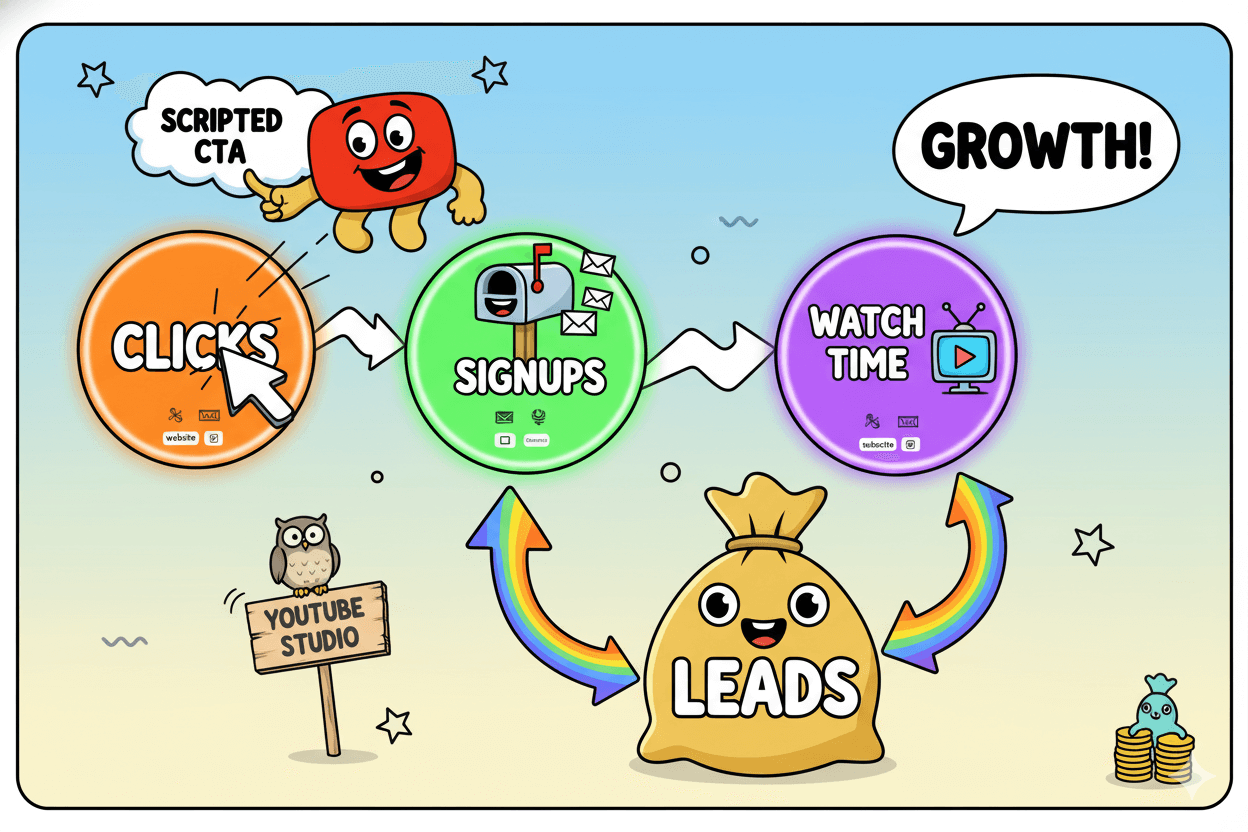
Keep your voice while you scale scripts
Lock your tone with Channel Voice, then trim repeats before you publish.
Channel Voice setup: Simple vs Advanced
Start in your channel’s Voice tab. Use Simple Mode to give natural-language feedback like “more conversational, fewer buzzwords,” and the system adjusts future drafts.
When you need precision, switch to Advanced Mode to tune specific dimensions such as tone, complexity, and narrative techniques, then save it as your default.
Subscribr’s own guidance defines Channel Voice as “the tone, style, and phrasing that makes your content sound authentically like you,” which is the right mental model when you compare outputs.
De-repetition checklist and Common Phrases
Repetition creeps in when you publish often. Subscribr adds a dedicated Edit step that scans your draft for repeats and trims them automatically.
If echoes remain, the help guide breaks repetition into two buckets—repetitive phrases and repetitive topics—with tactics to rewrite or rotate language for each.
Create a short Common Phrases list of words you love and ones you avoid. Use the list while editing to keep your voice consistent but not copy-pasted.
Subscribr’s repetition guidance recommends iterating this list over time as your series evolves.
Before/after: brand voice preserved
Run a one-minute test. Draft a short intro in Chat, then apply your saved Channel Voice and re-generate the same section.
The “after” should read with your rhythms—sentence length, word choice, even filler you naturally use—while staying on outline. If not, tweak Simple feedback or Advanced sliders and lock the change.
When the script is ready, place your spoken CTA and reinforce it with end-screen elements so your tone carries through to the final ask.
YouTube lets you add up to four end-screen elements in the last 5–20 seconds, which pairs cleanly with a natural, voice-true close.
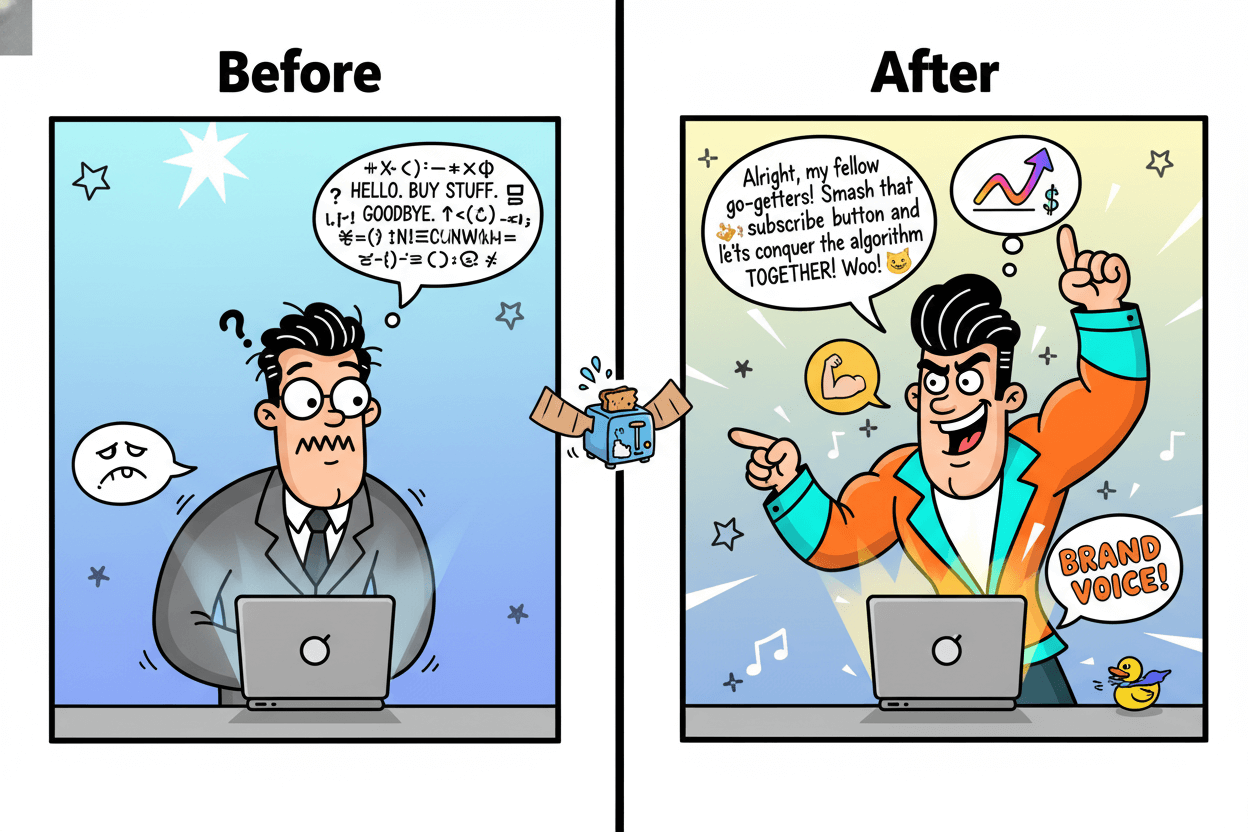
Pro tip: Re-read only the hook, CTA line, and transitions out loud. If they sound like you, the rest will follow your lead.
Research your niche fast with Intel and Outlier Remix
Pick topics with evidence. Intel shows winners; Remix adapts structure to your offer.
Intel basics: find trends and winners
Open Intel and use the search bar to explore your niche. You can look up channels, niches, or video types, then scan the dashboard for performance signals and AI notes about audience and content patterns.
Intel’s guides explain how to run broad discovery, analyze what outperforms, and turn those patterns into strategic choices for your next script. Think of it as market research built into your writing workflow.
Spot outliers and remix elements
High performers leave clues.
Intel’s workflow highlights outlier videos—uploads that get 5–10x the usual views or unusually strong engagement—and breaks down common success factors like opening beats, topic angles, and title/thumbnail patterns.
In Subscribr you can then Remix: extract the structural elements that worked, keep your story and examples, and rebuild the outline in your own voice.
You are not copying scripts; you are adapting proven structures that fit your audience and offer.
Save research with Bookmarks
When you find a channel, video, or example worth keeping, click Bookmark to store it with tags and notes. Over time you’ll build a searchable library of formats, hooks, and CTAs that worked in your niche.
Bookmarks are shareable with your team and ideal for recurring series, so every new script starts with a short list of proven references instead of a blank page.
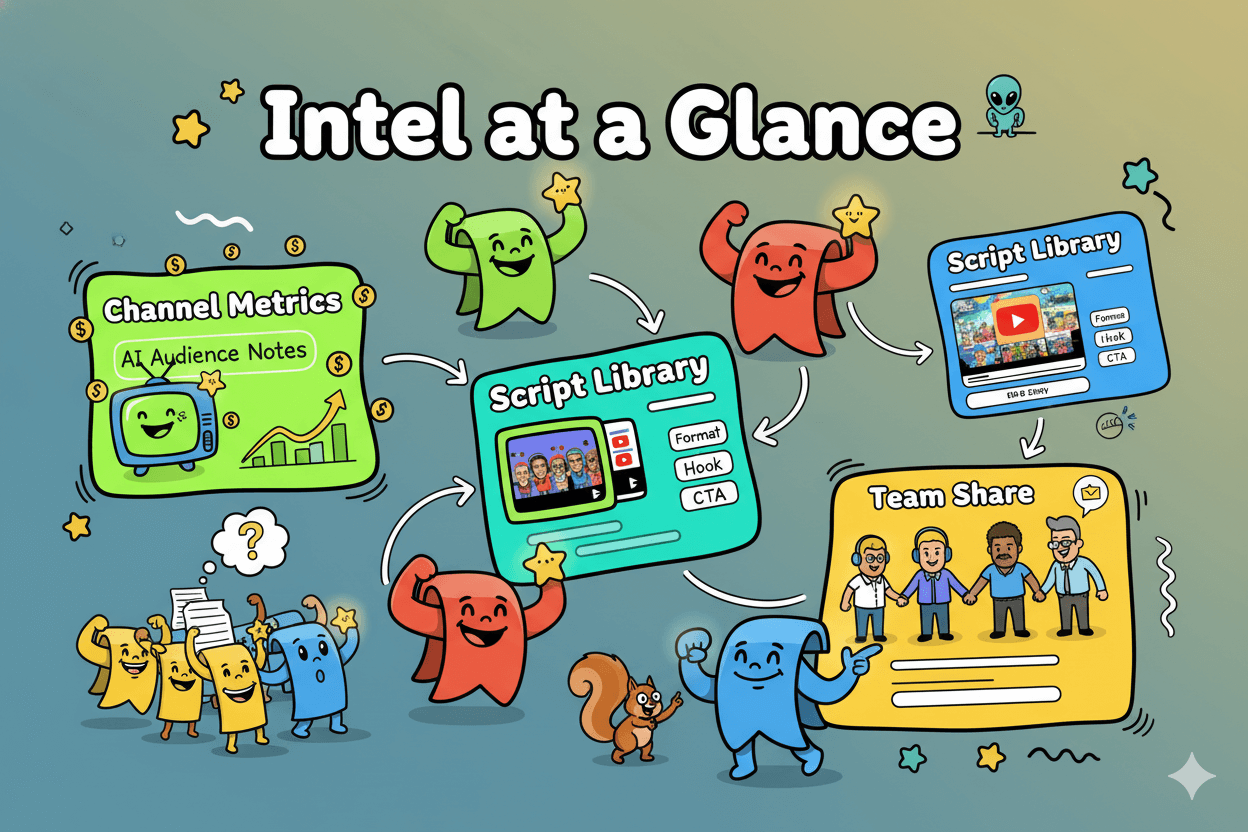
How to use this today
- Run a niche or channel query in Intel and sort by performance to spot outliers.
- Open one standout video and list the first three beats it uses to hook viewers.
- Click Remix to rebuild that beat pattern around your specific offer, then move the outline into Chat-to-Script for a fast draft.
- Save the source video and any title/thumbnail examples to Bookmarks for your team.
When you work this way, you publish with confidence. Your ideas start from evidence, your outlines follow structures audiences already reward, and your scripts keep your unique tone as you scale.
Intel and Remix make that loop repeatable.
From chat to outline to working draft in one place
Chat the idea, pick a format, generate the outline, draft each section, and ship.
Kickoff: Chat-to-Script and format pick
Begin in Ideation Chat. When a concept clicks, press Save Idea to convert that chat thread into a new script, then select your format and length in the guided setup.
For list-based ideas, choose Compilation/Listicle so each item becomes its own section automatically. This saves structural work and keeps your outline clean.
If you prefer to plan outside chat, the Welcome to Subscribr overview shows the same pipeline—research, framing, outline, draft, and edit—so you can enter at any step without losing context.
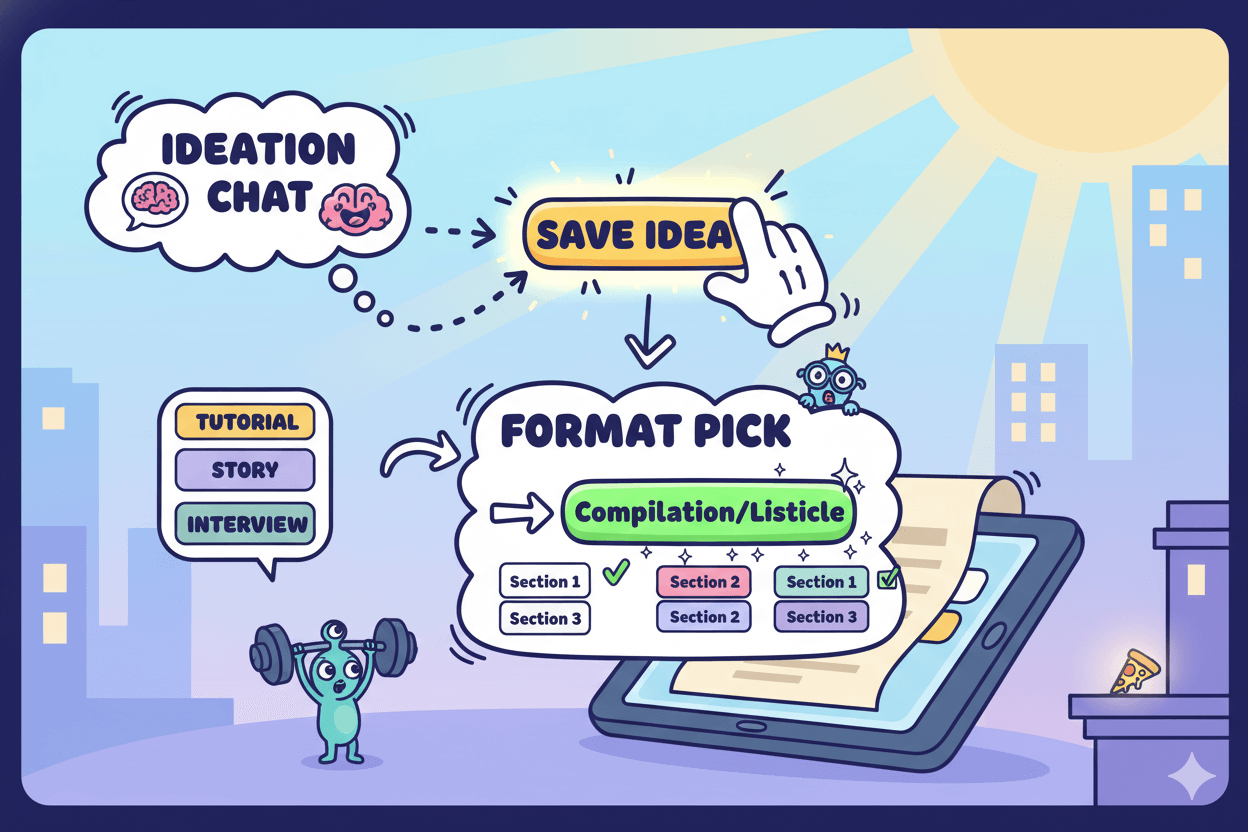
Outline to draft with Canvas-style, section-by-section edits
When you land on the Script page, Subscribr auto-generates an outline with multiple sections.
Open a section to see Plan / Research / Write tabs: set the focus in Plan, review source notes in Research, then click Generate Draft to write and accept text into Write.
Work through the script section by section, then export the full draft when done.
Research isn’t static. You can attach sources and even request Research Feedback before the outline is made; Subscribr will create section-specific research reports and refresh them if you add materials later.
Regenerate any section with updated research to keep facts tight and examples fresh.
Publishing on a deadline? Auto Draft can produce a full-script draft in one run. Review instructions first, then trigger Auto Draft to save time while you keep final edits human-led.
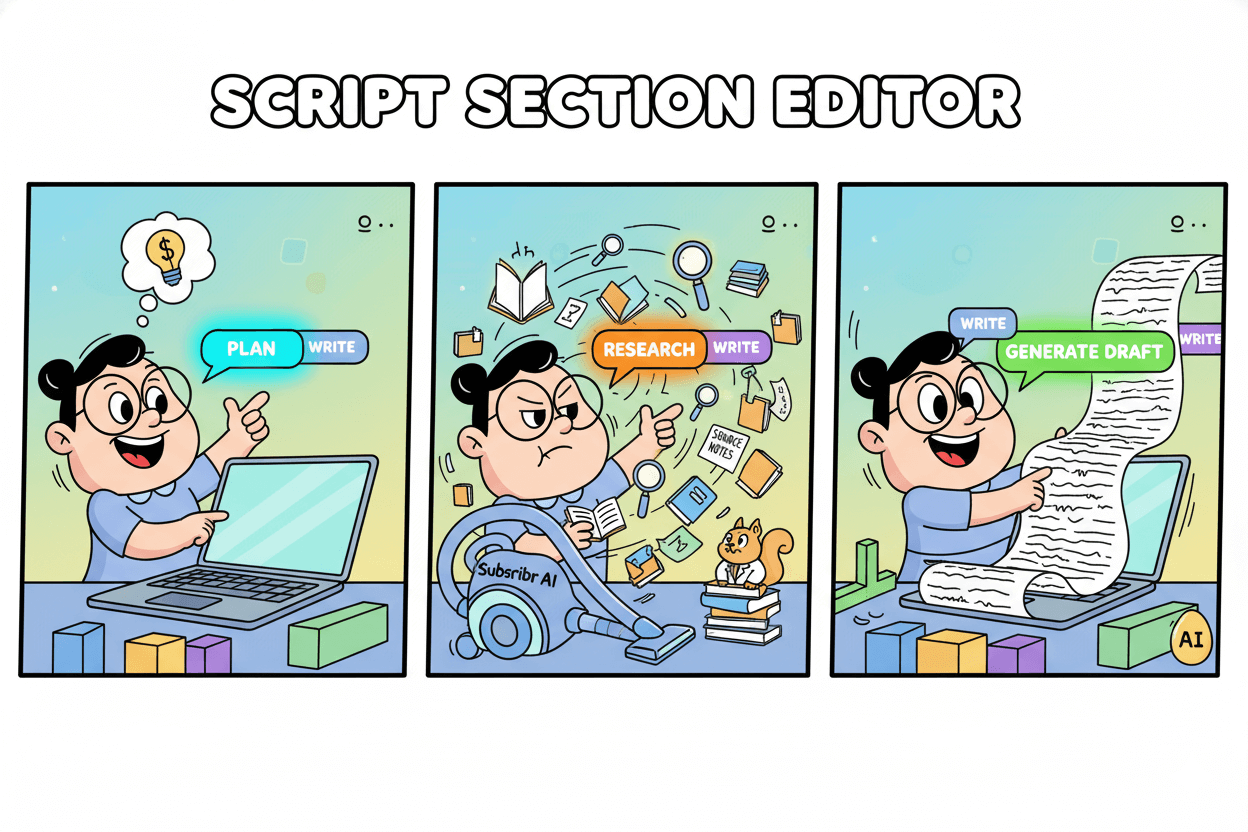
Choose the right writing model
You can pick which AI brain drafts your outline and sections. Subscribr supports multiple models and lets you switch anytime; your selection applies to new outlines and drafts, including the Generate Draft button.
Practical use: test models on one section, compare tone and pacing, then standardize your pick across the series.
Formats are flexible too. If none fits perfectly, choose Other and proceed; Subscribr notes that Compilation/Listicle is the one format with extra automation, but all formats will draft cleanly once your plan is set.
Pro tip: Set your Channel Voice, then generate one test section with each model. Keep the version that reads most like you and regenerates cleanly when research changes.
Scripts that drive website clicks and leads
One video, one ask. Script the line, mirror it in text, link first, and back it with end screens. – Databox
Map CTAs to intro, mid-roll, and close
Open strong and tell viewers what they’ll get if they follow your link. Use a single promise and repeat it once mid-video if the format is long. Close with the exact line you’ll say on camera and point to where to click.
Databox’s roundup shows creators lift CTR with tighter messaging and clearer asks, which pairs well with scripted placement.
do’s_and_don’ts: Do pick one CTA per video. Do script the exact sentence. Don’t stack multiple offers that split attention. Back the close with a matching end screen and the first link in your description.
On-screen text, description links, and end screens
Put the primary link at the top of the description with simple labels so viewers know what happens next. YouTube’s guidance explains how to showcase links and when they’re clickable, including limits on Shorts links.
End screens can include up to four elements in the last 5–20 seconds; use one for your “Next step” video and one for Subscribe, then keep the layout uncluttered.
Recent updates let viewers hide end-screen overlays. Early reports suggest a small impact on clicks, so keep your spoken CTA and description links strong even if some viewers turn overlays off.
This keeps your path to action resilient across sessions.
Example CTA lines for services and local offers
Service business: “Need a same-day quote? Tap the first link, pick a time, and I’ll hold your spot.” Local offer: “Want the printable checklist I use with clients? It’s the first link under this video—grab it and follow along today.”
For business channels, Subscribr’s playbooks stress clear hooks and packaging so your CTA feels natural, not bolted on. – Verge
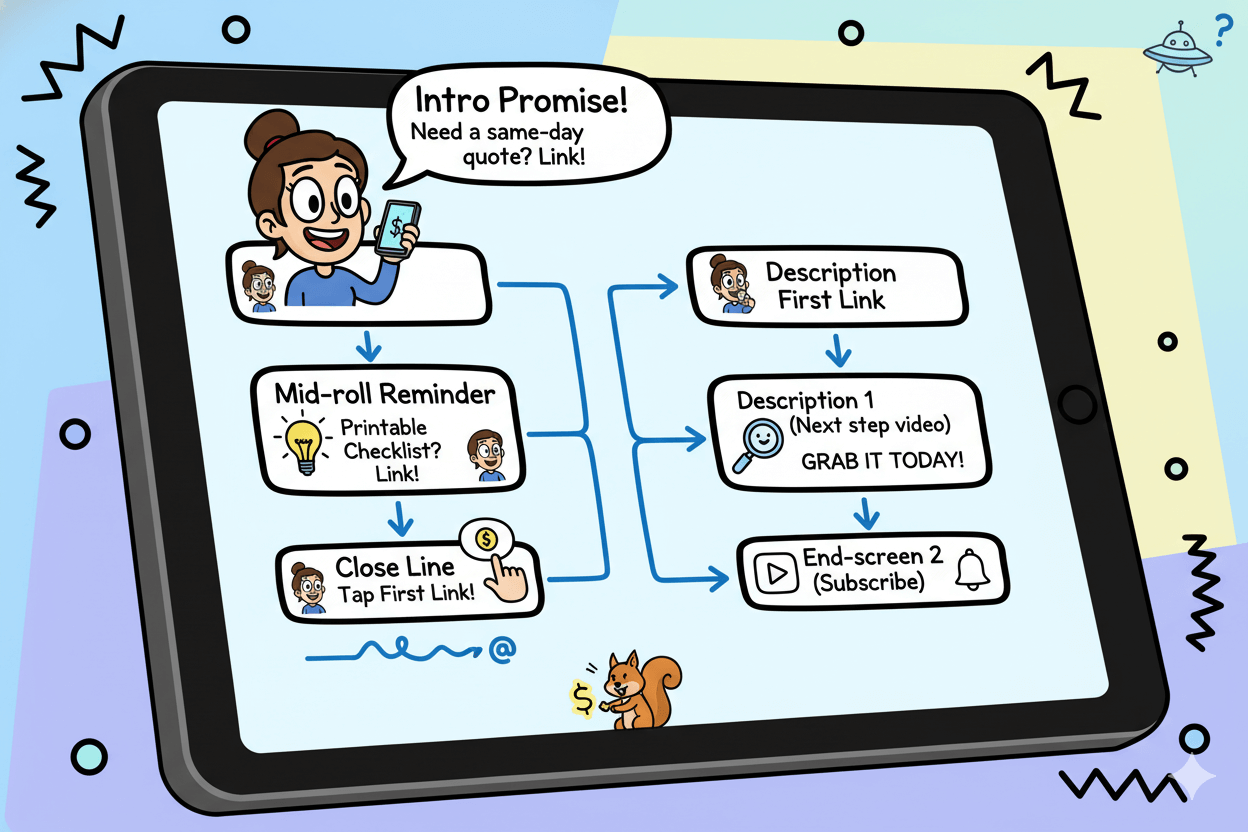
Micro-challenge: Record the closing line twice: one calm, one urgent. Publish the version that matches your offer’s pace, then review end-screen and link clicks in Analytics next week.
Frameworks that fit small businesses
Use Problem–Solution, AIDA, or Listicle—simple rhythms your audience already trusts.
Problem–Solution for services
Open on a specific pain your customer feels. Show the quick fix or process, then invite them to take the next step with you.
Creator guides emphasize a strong hook and a clean arc so viewers track from struggle to outcome without friction; keep language plain and spoken.
In practice: script a one-sentence problem, three bullet fixes, and a closing line that points to your booking or lead magnet. Treat it like a mini case study, not a lecture. – Later
AIDA for promos and launches
AIDA gives you four moves: Attention, Interest, Desire, Action. Lead with a vivid hook, build interest with a benefit, shift to desire with a quick proof or visual, then ask for one action.
Modern copy resources still recommend AIDA for small-business marketing because it’s easy to follow and converts across channels.
Use this when you have a time-bound offer or a single clear product pitch. In your script doc, label each paragraph with A, I, D, or A so you don’t lose the thread.
Listicles for discovery
Listicles shine when people are browsing or comparing. Subscribr’s Compilation/Listicle format lets you enter items up front and automatically creates one section per item, which speeds drafting and keeps pacing tight.
The help docs also note that listicle is the one format with extra automation today; use it for “Top 7 tools,” “5 myths,” or “8 steps” videos where structure matters more than narration style.
After drafting, add a single CTA that references the list, like “Get the full checklist at the first link.”
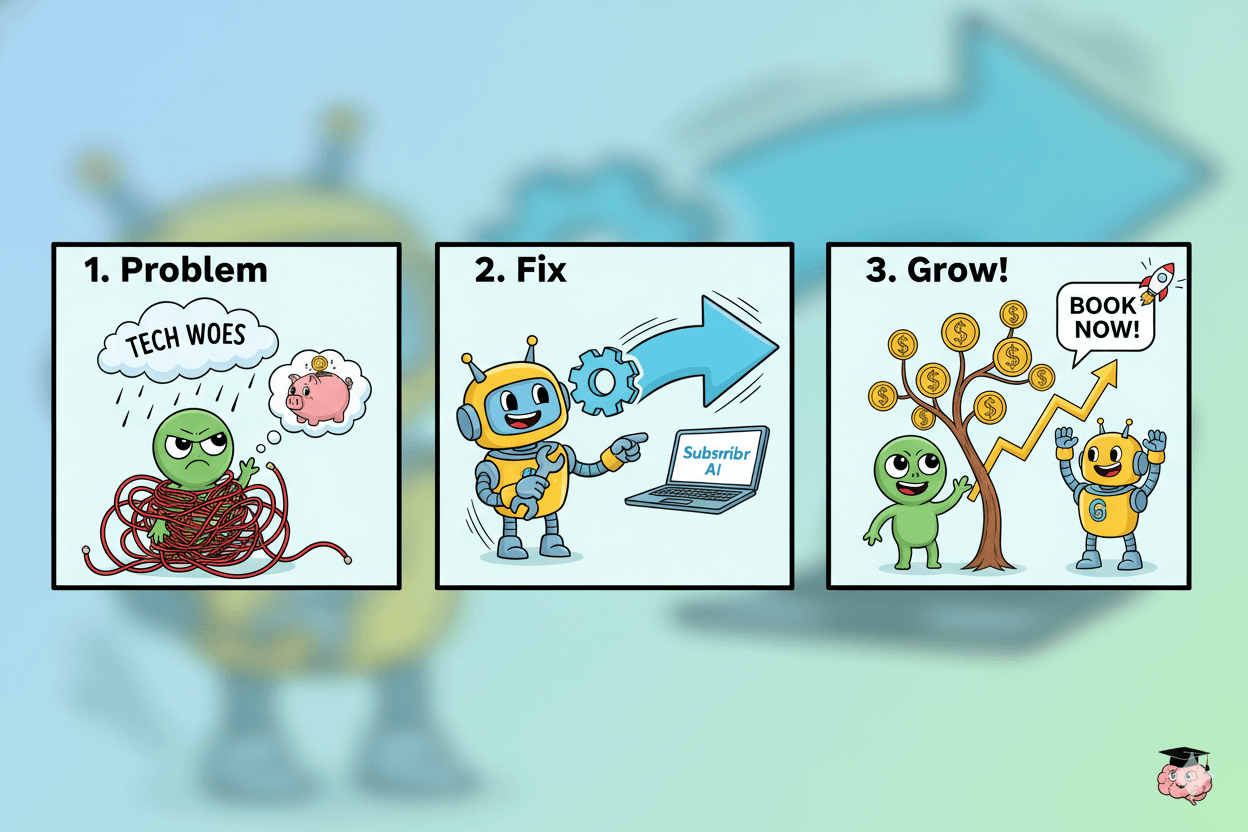
Pro_Tip: Pick one framework for an entire series so your viewers learn the rhythm. When you switch, explain the new format in the first ten seconds to preserve trust and watch time.
Speed, models, and collaboration: working smarter in Subscribr
Standardize your writing model and share a bookmark library so the team ships weekly.
Pick a writing model for each series
Subscribr lets you choose among multiple AI draft models. Each model carries different pacing and phrasing tendencies, and you can switch anytime as a project evolves.
Practical move: lock your Channel Voice, draft the same section with two models, then standardize the winner across that series. This balances speed with a tone that still feels like you.
before_after: Draft a 120-word intro with Model A, then regenerate with Model B using the same Channel Voice. Keep the version that reads smoother and keeps your cadence intact, then apply it across the outline.
Centralize research with Bookmarks
Your best time-saver is a library you trust. Bookmarks let you save channels, videos, and ideas from Intel, tag them by series or offer, and share them with collaborators.
Over time you build a searchable bank of hooks, formats, and competitors to reference before you ever prompt the model. It’s faster than digging through scattered docs and it keeps everyone writing from the same playbook.
Pro_Tip: Tag saved items by funnel stage—Awareness, Consideration, Decision—so each new script starts with examples aligned to your CTA style.
Weekly cadence for small teams
Batch the steps. Monday: pull three outlier topics from Intel and drop them into your team’s Bookmarks. Tuesday: pick one, run Chat-to-Script, and choose the writing model for this series.
Wednesday: draft section-by-section in the editor, watching status badges so nothing gets stuck in “Needs Research.” Thursday: record or hand off. Friday: review clicks from description links and end screens, then update next week’s shortlist.
If you work with collaborators, choose a plan that matches your team and channel count. The pricing page lists member limits, channels, and monthly credits per tier so you can size capacity to your release schedule.
Start with the plan that covers this quarter’s cadence and revisit when you add series or editors.
Operating checklist (save this):
- Lock Channel Voice.
- Test models on one section, pick a standard.
- Create Bookmarks folders per series and offer.
- Run a Monday Intel sweep and tag three candidates.
- Draft by sections mid-week; keep status badges green.
- Publish with a single CTA plus end-screen support.
- Review clicks and refine next week’s list.
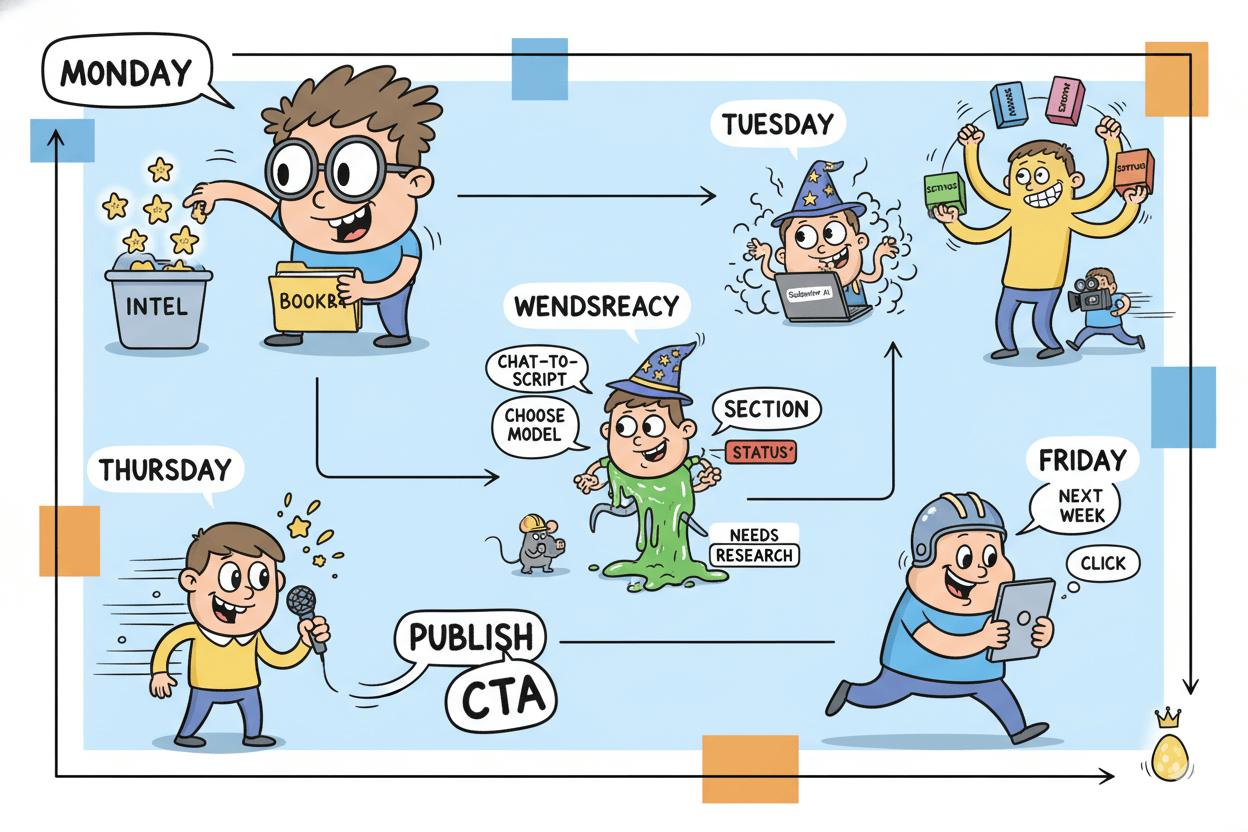
Alternatives and how Subscribr compares
Many tools write; fewer research, remix, and keep your voice in one place.
Where Subscribr is uniquely strong: Intel + Voice + Remix
Subscribr builds strategy into the writing step. Intel scans niches, channels, and videos so you can target outliers and rising trends with evidence, not hunches.
Remix turns those outlier patterns into fresh outlines for your offer. Channel Voice locks tone and phrasing so drafts still sound like you as output increases. That research→structure→voice loop is the differentiator.
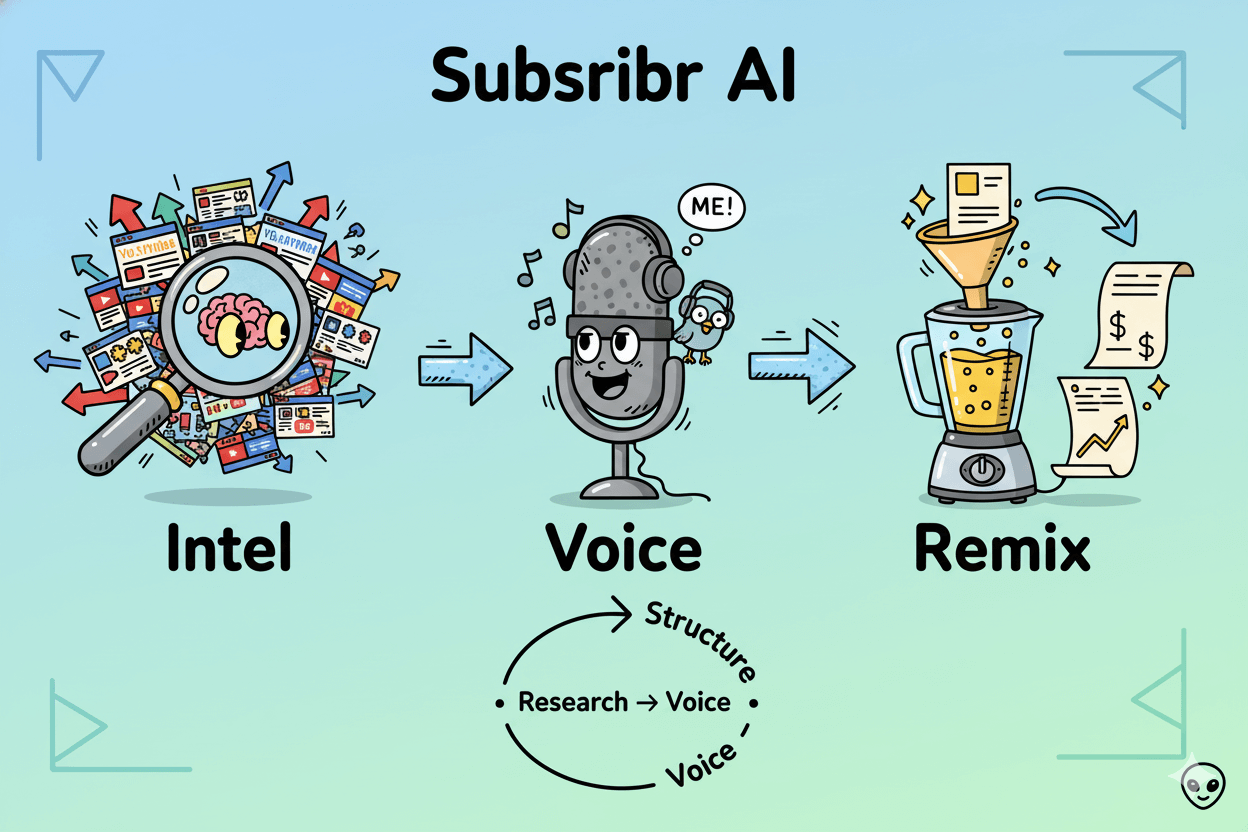
When another tool might fit
If you want a quick script from a single prompt and you plan to do strategy elsewhere, vidIQ’s AI Script Generator is a fast, focused option with tone controls and companion ideation tools.
If your main need is editing recorded footage and producing finished videos, Descript excels at text-based video editing, transcription, and pacing guidance; its 2025 guides double as solid pedagogy for hooks and story arcs even if you draft scripts in another app.
Choose the tool that matches the bottleneck you actually have.
Stack example: research in Subscribr, edit elsewhere
A practical stack for small teams: run Intel to find a breakout angle, Remix the structure, set Channel Voice, and draft sections inside Subscribr.
Export your script and produce in Descript if you need transcript-based editing and cleanup; publish with your scripted CTA and end-screen plan.
This keeps topic selection and scripting where Subscribr is strongest while letting a dedicated editor finish the video.
Best-for matrix (reader’s quick take)
- SubscrSubscribr Aiibr: Research-driven scripting, voice control, outlier remixing, section-by-section drafts. Use when you want ideas that map to proof and brand-true language at scale.
- 1of10: Rapid one-prompt scripts and surrounding creator utilities like idea and thumbnail helpers. Use when speed-to-first-draft is the only goal.
- Descript: Post-script production and editing; strong for teams that edit by text and need transcripts, cuts, and polish. Use when editing is the main workload.
If you’re chasing leads, pick the stack that shortens the path from evidence to on-brand script to clear CTA. Subscribr owns that middle—and that’s where growth compounds.
Conclusion
You don’t need a bigger team to win on YouTube. You need a repeatable path from idea to on-brand script and a clean CTA that sends viewers to one next step.
Subscribr gives you that path: research what’s working with Intel, capture the angle, and rebuild proven structures with Remix so you never guess in the dark.
Lock your Channel Voice so drafts sound like you, not a template. Then move from chat to outline to draft in one workspace, editing section by section until it’s tight and ready to record.
When you publish, stack your spoken CTA with description links and end-screen elements so action is obvious and easy. Keep the offer singular and the language plain.
This simple flow—Intel → Remix → Voice → Draft → CTA—turns views into leads without extra complexity.
Your quick start: run one Intel search for your niche, press Remix on a standout video, set Channel Voice, and generate a first draft. Add your end screen and first link, hit upload, and review results next week.
Repeat the loop and let the wins compound. To stay consistent, block a weekly one-hour slot for Intel, drafting, and a final CTA check.
That cadence builds a library of on-brand scripts and keeps your channel moving toward measurable clicks and signups.

Subscribr AI: Research, Remix, and Write Like a Pro




